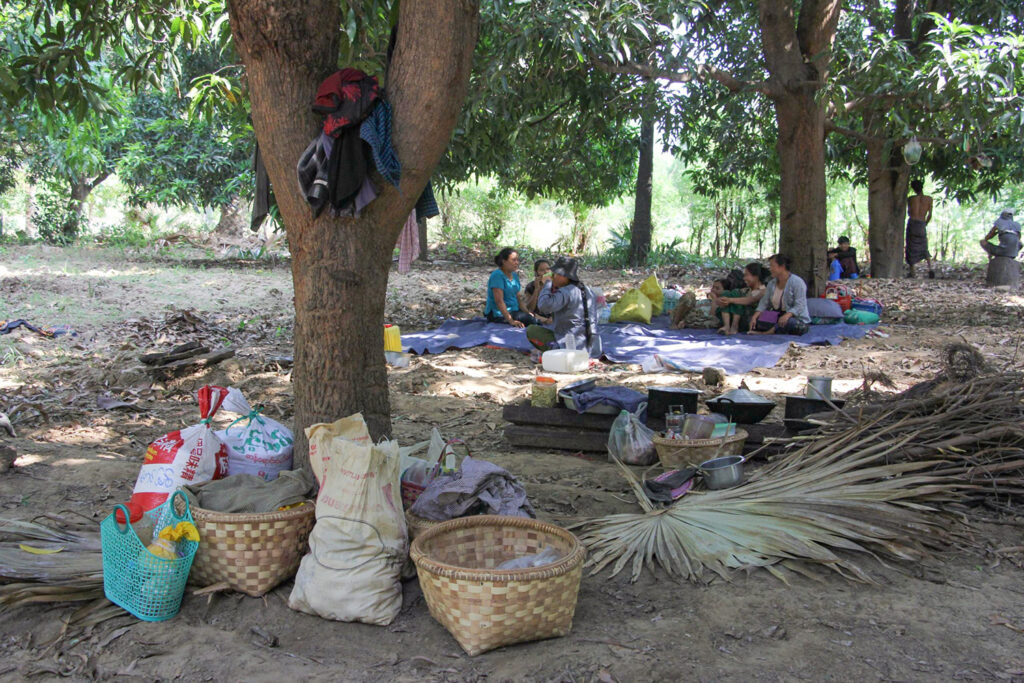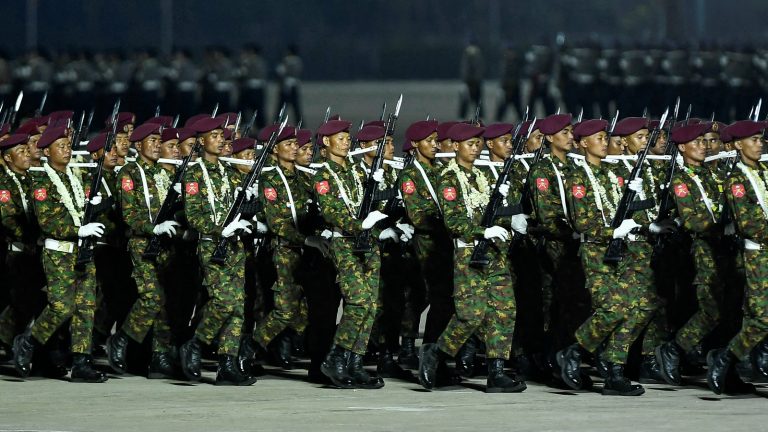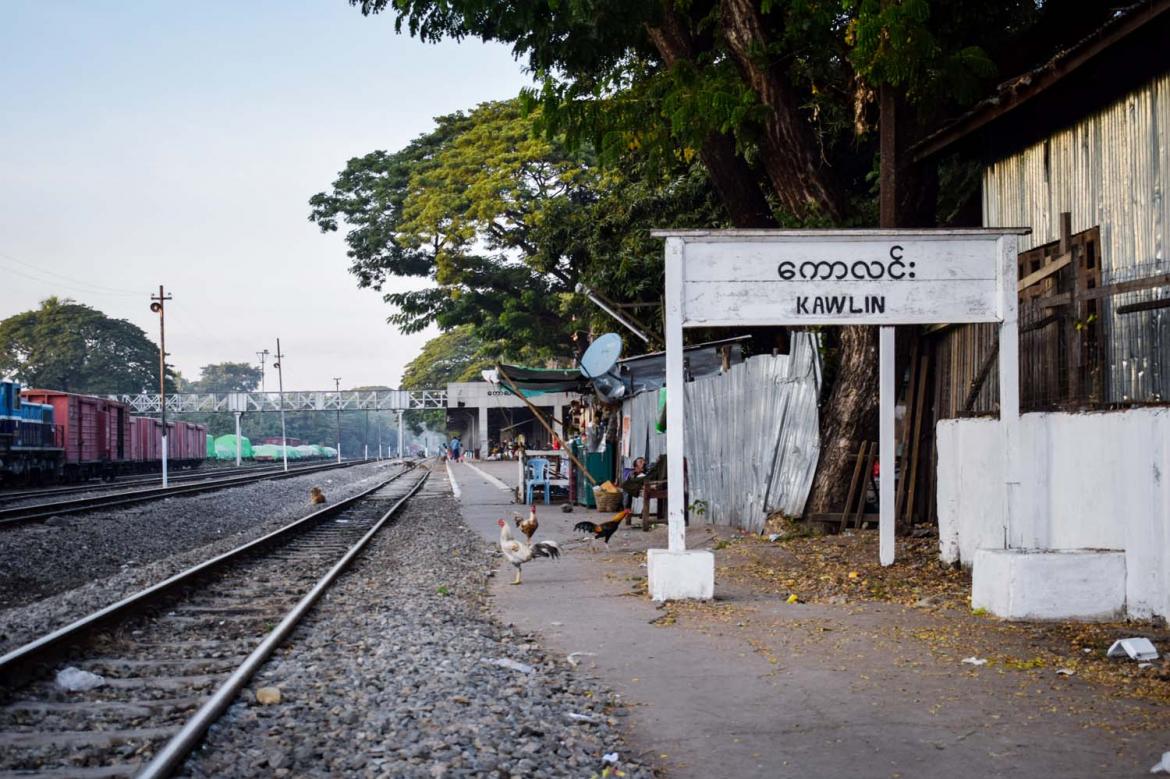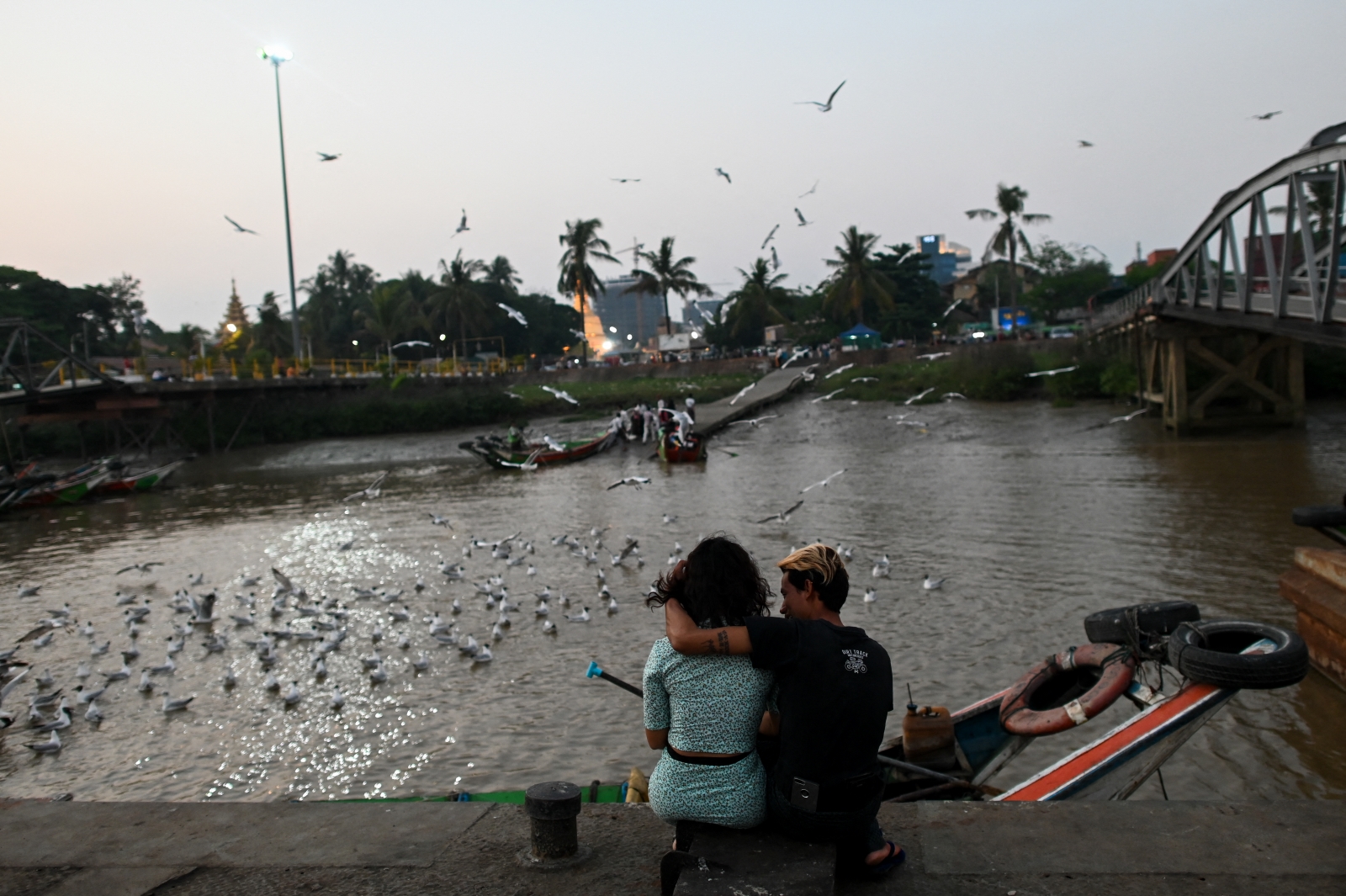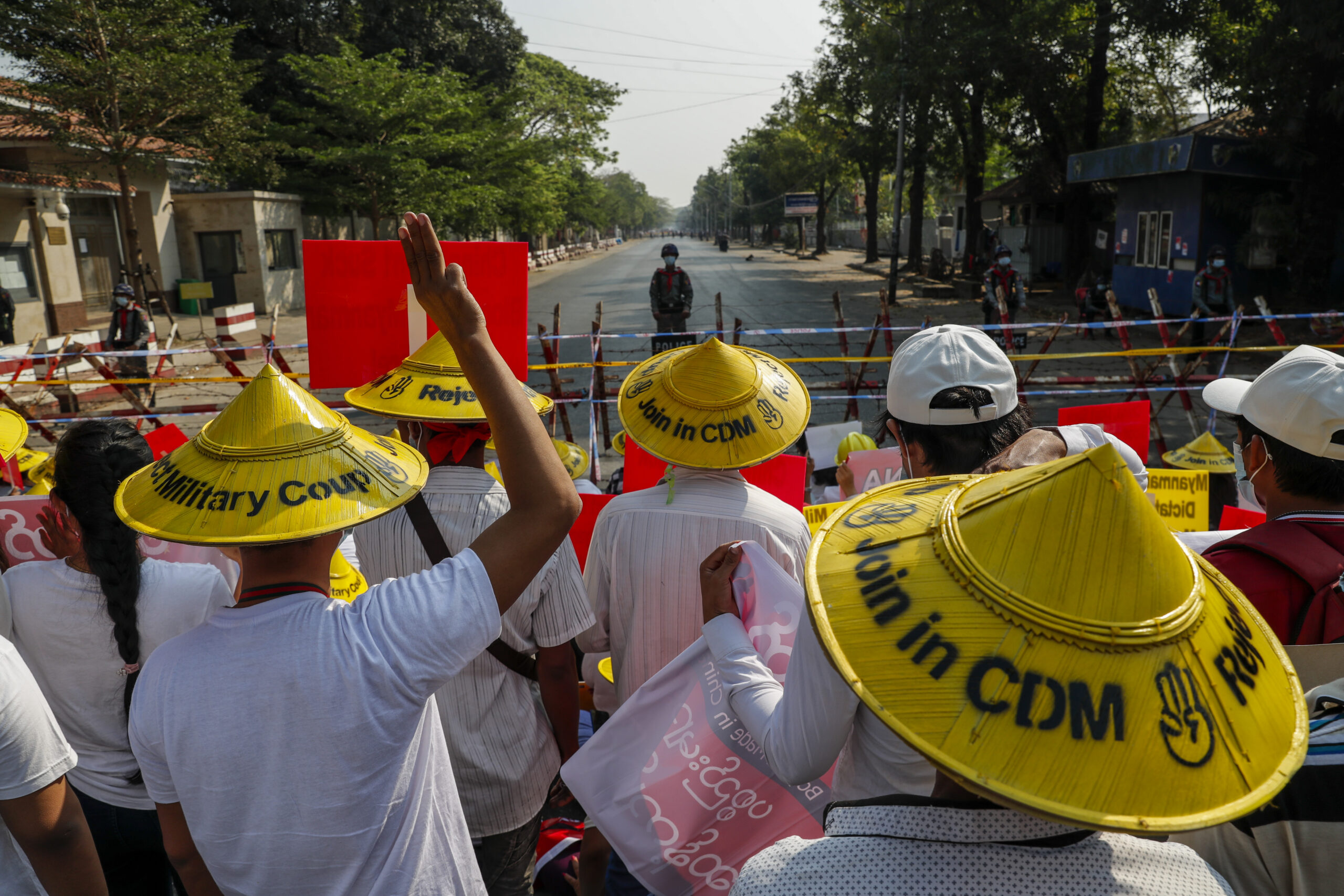The raging conflict and the junta’s crackdown on civil society has made it more difficult for civilians in central Myanmar to access water, forcing them to undertake dangerous journeys or drink from unhealthy sources.
By FRONTIER
Sitting under the blazing 43-degree Celsius heat in Sadaung village, Ko Min Naung* stared despondently at what was once a four-acre lake.
“There are two big lakes in the village. Now both are dried up,” he told Frontier in early April. “We can produce groundwater, but it’s salty. We can’t drink it; we can only use it to shower.”
This is not an unusual development for the Sagaing Township village. In fact, it’s a yearly phenomenon that occurs every April and May, during the hot season in an area of Myanmar known as the Dry Zone. In years past, Sadaung residents simply transported water from nearby villages, not giving much thought to what was just a minor inconvenience at the time.
But this year the situation is different, as violent clashes rage between the junta and resistance groups known as People’s Defence Forces, formed in opposition to the 2021 coup and the military massacres of peaceful protesters.
“In order to retrieve water from other villages, we have to listen for news about the military forces first,” said Min Naung, explaining they rely on online news sources like Telegram channels and phone calls with contacts in surrounding villages.
“We only dare to fetch the water if we are sure the road is clear. We also have to avoid the villages where the military troops are based. We therefore sometimes need to go far away to reach a water source,” he added.
In days gone by, the image of ox-drawn wagons carrying water was a common symbol of central Myanmar’s pastoral way of life. But now, it’s a practice that draws more attention, makes it harder to flee, and puts valuable cattle at risk.
“Mostly we use motorbikes to carry the water now, but we cannot carry as much water as we could with the wagons,” Min Naung said.
The situation is even more dire for those displaced by the conflict, like 50-year-old Daw Soe Shin*, who have had to flee their homes and shelter in nearby forests.
A resident of Hlay Oo Kan village in Sagaing Region’s Myinmu Township, Soe Shin said she has gotten into the habit of always keeping six or seven one-litre water bottles filled and ready in case she needs to escape a military attack.
“It’s not a problem if we can flee to a village that has fresh water. But if we have to flee to a place where there is no water, we need to carry water with us. If we have to stay for longer than we expect, we have to take risks to return to near the village and fetch more water,” she said.
Soe Shin said following military raids on her village, residents have returned to find that Tatmadaw troops had destroyed tools used for extracting groundwater and the large clay containers used to store it, seemingly with the intention of denying civilians access to water.
Dr Ngai Tam Maung, deputy minister of Ministry of Humanitarian Affairs and Disaster Management for the parallel National Unity Government, told Frontier that the military regime is trying to starve out civilians.
“People are being prevented from accessing food and water. The military use all their efforts to destroy the lives of the people,” he said.

Civil society hobbled
In past years, when the Dry Zone suffered from its annual water shortages, the local administration, civil society organisations and volunteer charities all pitched in to distribute water to villagers in need.
But this is no longer possible due to the conflict, both because these groups have trouble accessing areas in need, and because these communities have become intensely suspicious of outsiders.
“No one except our villagers are allowed to enter the village,” said U Soe Maung*, a resident of Htoe Po village in Wetlet Township. “They are very strict about strangers.”
He said due to fear of dalans, or military informants, donors can only give through the PDFs or other local defence forces and are not allowed to enter the village to directly distribute water or money.
At the same time, the junta is allegedly trying to starve these areas of supplies, as part of its infamous four-cuts strategy that it has employed for decades in an attempt to cut off insurgent groups by targeting their civilian support bases.
According to local charity groups, the junta’s regional administration in Sagaing ordered them not to do anything except transport patients and dead bodies with hospital documents. Ko Linn Htin*, leader of the Alinn Thit Payaheta group based in the regional capital Monywa, said that ambulances are forced to stop at many junta checkpoints while transporting patients.
“Never mind donating water and food to the villages, we can’t even leave the town with the goods. We would be arrested immediately,” he said. “Even to carry patients from the villages, we need to inform the township police station first.”
Since the coup, the regime has cracked down on charities and civil society organisations that have long played important roles in Myanmar, providing people with funds, emergency medical care and funeral services. Many groups have been forced to suspend operations while being hounded in military-controlled courts for allegedly assisting resistance forces, or have been ordered to comply with onerous new regulations. Operations in conflict zones have become particularly hazardous, and aid workers say people are dying because of the barriers they face.
Linn Htin said there used to be hundreds of charity groups based in Monywa, but only 10 are still operating today.
“In our region, both sides are powerful, so traveling is very difficult and dangerous. When traveling from one place to another, we might be misunderstood and shot at by either side. Therefore, most groups do not want to go and help people outside of the town anymore,” he said.
The NUG deputy minister Ngai Tam Maung also blamed international NGOs, as well as United Nations agencies, for cooperating with the junta and failing to provide assistance to IDPs in the Dry Zone.
“Frankly speaking, INGOs [and] UN agencies are prioritising maintaining their presence in the country, rather than helping the people who need humanitarian assistance the most,” he said.
International agencies have come under fire for presenting credentials to the regime and continuing to meet with junta officials. Others say this lip service is necessary to continue operating in the country, where they can provide assistance to some people in need, like IDPs in Rakhine and Kachin states, even if they are denied access to places like Sagaing.
PDFs try to fill the gap
Local PDFs and their affiliated civilian administrations are trying to fill the gap with funds they’ve been given by supporters opposing the military coup. Much of the resistance is supported by crowdfunding by the Myanmar public and the diaspora.
Bo Kauk Yoo, spokesperson of the Eagle Guerrilla Force based in Wetlet Township, told Frontier that the group distributes water in various IDP camps and villages suffering shortages.
“We arrange the process on behalf of the donors. The local and international fundraising groups are helping the people through us,” he said.

The NUG said it is aware of the problem of water shortages in Sagaing and that the humanitarian affairs ministry is conducting an analysis of the needs on the ground, while also connecting with local and foreign donors.
“In the villages of some townships, under the supervision and control of the relevant administrative officers and with the participation of local people, we are working to repair old earthen pots to collect water in the next rainy season,” Ngai Tam Maung said.
He said the ministry is working with NUG-affiliated local administrative bodies, resistance groups, resistance-aligned charity groups and deposed members of parliament.
However, on the ground, many PDFs told Frontier that they are forced to fund these initiatives on their own, without support from the NUG. It’s a common story, also heard amid efforts to raise money to buy weapons, as it’s harder for the NUG to access Sagaing, in central Myanmar, than other resistance strongholds on the Thai border.
A member of an NUG-affiliated PDF in Shwebo District said the group has even had to divert funds raised to buy weapons in order to bring water to IDPs.
“We can’t buy new weapons. When we see the people are in need of water, food and medicine, we can’t stand by and watch. We have to use the money to help the people,” he said.
Some desperate villagers have taken to drinking muddy and impure water to stay alive, but this has corresponding effects on public health, such as causing widespread diarrhea outbreaks.
Ma Khin Oo*, a displaced villager from Kani Township, said many people in her camp drink muddy water from still, drying up ponds. She said there are some fresh streams not too far from the camp, but people are too scared to collect water there because they flow alongside a village controlled by the Pyusawhti, a paramilitary force loyal to the regime.
“We have to drink water that isn’t suitable for drinking. The water is muddy because the ponds and wells are drying up,” she said.
Pyithu Oh Eain, a PDF-affiliated social welfare group operating in Kani Township, said that there is a shortage of medicine to treat IDPs suffering from diarrhea and other problems caused by unclean water, like skin rashes, because it is difficult to import medicine to the region.
“Even if we have the funds, it is very difficult to transport medicine to the township,” said Naw Shu Mai, a member of Pyithu Oh Eain. “People are often arrested on the street while carrying medicine.”
This is reminiscent of a similar military tactic deployed in Rakhine State when fighting briefly flared again last year between the Tatmadaw and the Arakan Army.
Shu Mai said they want to go into each IDP camp at least twice a week to assist sick civilians but can only safely do so three or four times per month.
Bo Kauk Yoo said that the Eagle Guerrilla Force had opened a clinic in Wetlet Township where they treat diarrhoea patients, but funds are limited.
“Based on the funds that we received, we treat them as much as we can. Our members have to attack military forces, distribute water and food to the villagers and provide healthcare,” he said. “We have to do it all.”
But in Sadaung, Min Naung said neither PDFs, charity groups nor NUG officials have come to their aid.
“Maybe their donations cannot cover the entire area that needs water. In our village, no group has come to distribute water yet during this hot season,” he said.
*indicates the use of a pseudonym for security reasons


